2012 VOLKSWAGEN GOLF MK6 headlights
[x] Cancel search: headlightsPage 221 of 516

Lights and vision
Lights
lights . . . . . . . . . . . . . . . . . . . . . . . . . . 122
Turn signal lever and high beam switch . . . . . 123
Switching li ghts on and off . . . . . . . . . . . . . . . . 124
lights and Vision functions . . . . . . . . . . . . . . . . 125
and reading lights . . . . . . . . . . . . . . . . . 127
A lways obey loca l ve
hicle lighting laws.
The drive r is always responsible for the correct
headlight settings.
More information:
Exterior views
Volkswagen
Changing a light bulb
Headlights that are aimed too high and
an d distract other drive rs. This can lea d to a crash and serious personal injuri es .
Always make sure that are properly adjusted .
or distrac t other drive rs .
Lights up Possible cause
or more driving lights not wor king .
. Adaptive Front lighting ma l-
function.
Fog lig hts switched on (ind icator light on the
headlight switch).
L eft
or right turn signal. The indicator light blinks twice as fast if a turn
signal is not working on the vehicle or the
t r a iler .
Daytime running lights
High beams switched on or headl ight nashers
i n u se.
When the ignit io n is sw itched on, several warning
and indicator lights come on
122 Before driving Prope
r response
Replace burn ed out bulb
all light bulb s are
Fa cility .
125
123.
Page 223 of 516
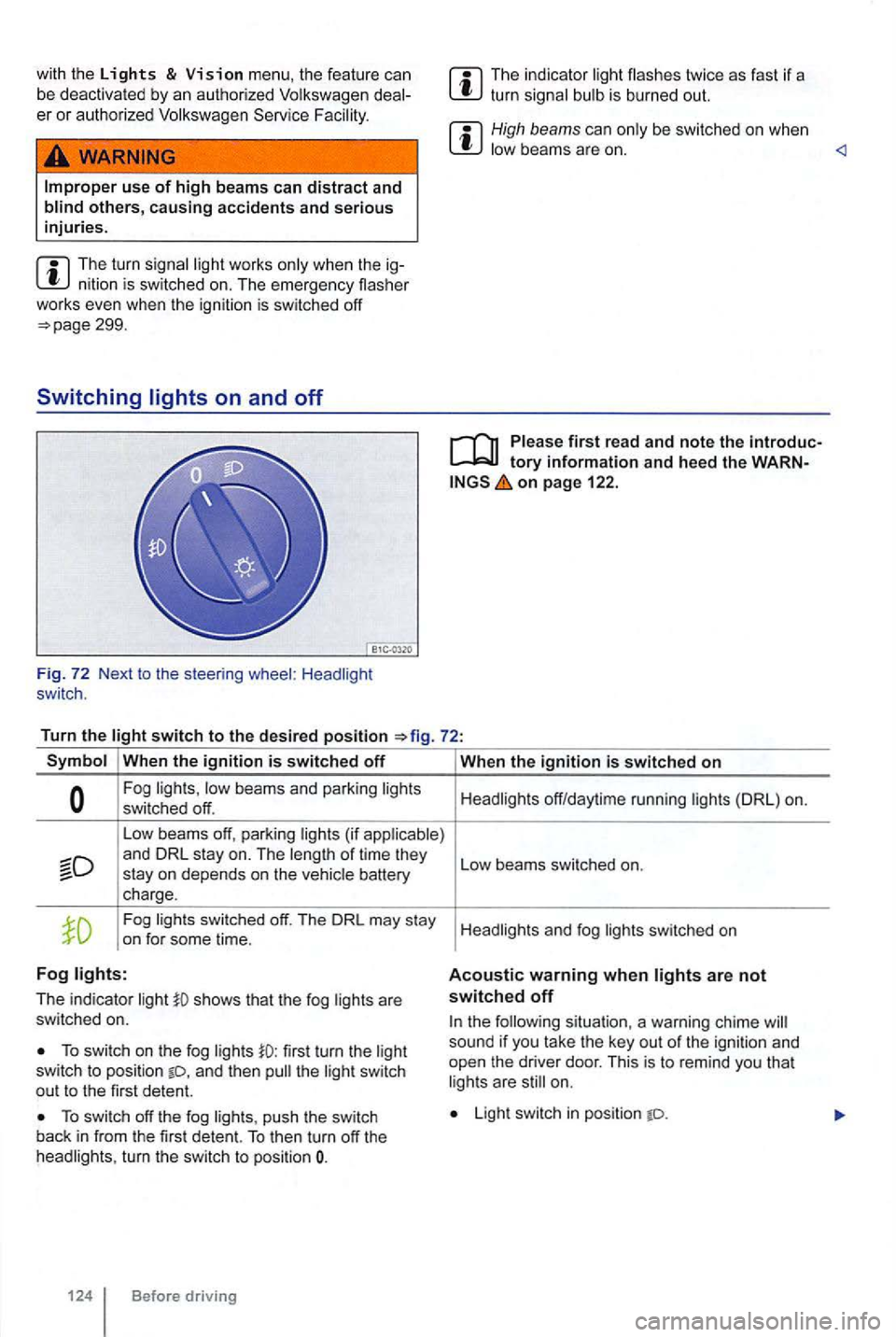
with the Lights & Vision menu, the feature can
be deactivated by an authorized Volkswagen deal
er or authorized Volkswagen Service Facility.
use of high beams can distract and blind others, causing accidents and serious injuries.
299.
Switching
The indicator twice as fast if a turn signa l bulb is burned out.
High beams can only be switched on when low beams are on.
Turn
the switch to the desired position
Symbol When the ignition is switched off
Fog lights, low beams and parking lights
switched off.
Low beams off, parking lights (if applicable)
Fog lights switched off. The DRL may stay
on for some time.
Fog lights:
The indicator li ght shows that the fog lights are
switched on.
To switch on the fog lights first turn the light
switch to posi tion and then the li ght switch
out to the first detent.
To switch off the fog lights , push the switch
back in from the first detent. To then turn off the
headlights , turn the switch to position
124 Before driving When
the ig
nition is switched on
Headlights off/daytime running lights (DRL) on.
L
ow beams switched on.
H eadlights and fog
switched on
Acoustic warning when lights are not switched off
the following situation, a warning chime sound if yo u tak e th e ke y out of the ignition and
open the driver door. This is to remind you that
l ig hts are still on.
Light switch in position
Page 225 of 516
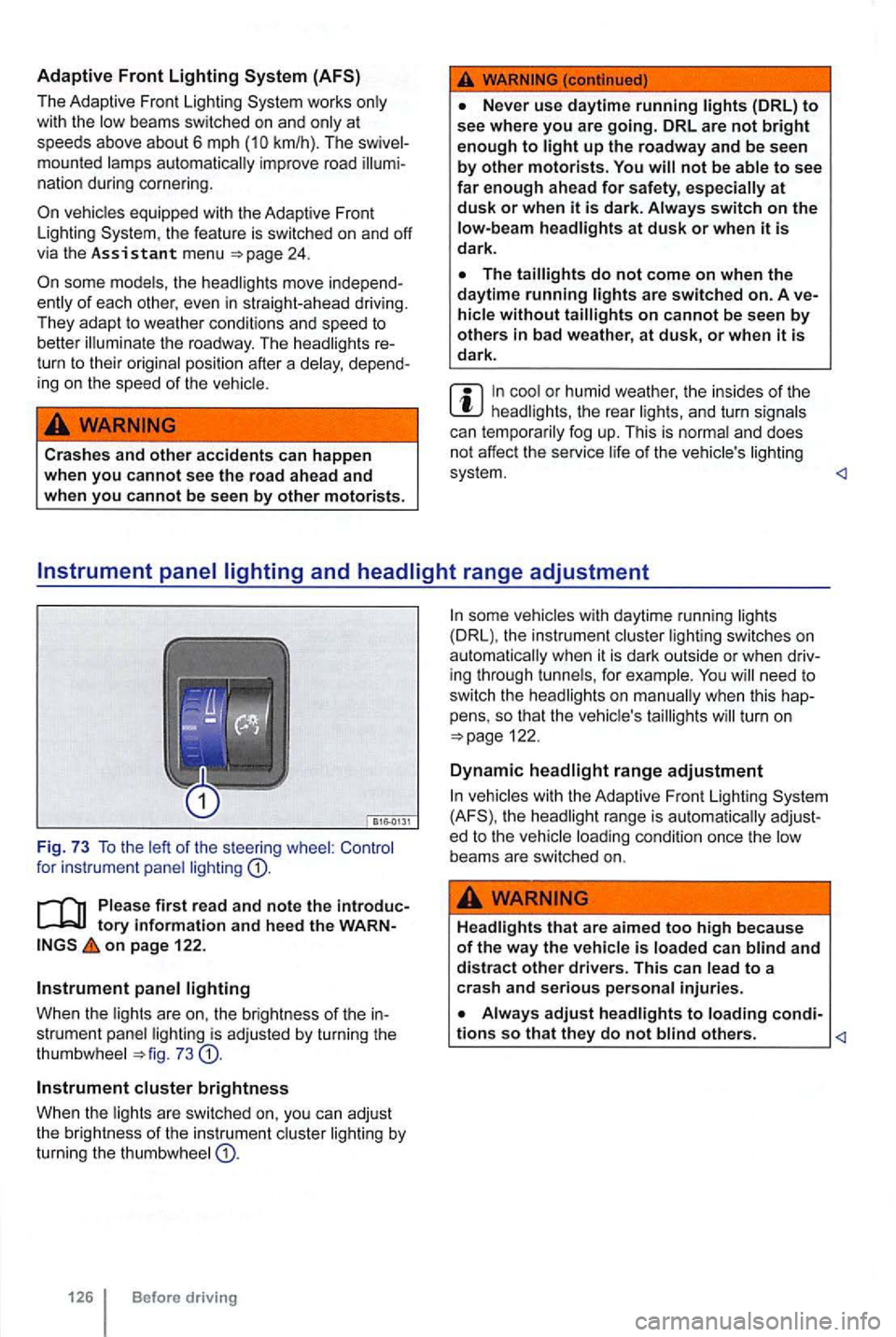
Adaptive Front Lighting
The Adaptive Front Lighting works only
with the low beams switched on and only at
speeds above about 6 mph
improve road
vehicles equipped with the Adaptive Front
Lighting the feature is switched on and off
via the Assistant menu
the roadway. Th e headlights re
t urn to their original position after a delay , depend
in g on the speed of the
Crashes and other accidents can happen when you cannot see the road ahead and when you cannot be seen by other motorists.
not be able to see
f a r enough ahead for safety, especially at dusk or when it is dark . Always switch on the low-beam headlights at dusk or when it is dark.
The taillights do not come on when the daytime running lights are switched on. Avehicle without
cool or hum id weather, th e insides of th e headlights , th e rea r li ghts, and turn signals
can temporarily fog up. This is normal and does
not affect the service life
of the vehic le's lightin g
system.
Instrument panel lighting
Whe n the lights are on, the brightness of the in
strument panel lighting is ad justed by turning the
thumbwhee l
Instrument cluster brightness
Whe n t he lights are sw itched on, you can adjust
the brightness of the in strument cluster li ghting by turning the thumbw hee l
Before driving
some vehicles with daytime running lights
(DRL), the instrument lighting switches on
need to
switch the head lights on
turn on
the headlight range is
Headlights that are aimed to o high because of the way the vehicle is loaded can blind and distract other drivers. This can lead to a
crash and serious per sonal injuries.
Always adjust headlights to loading condi-tions so that they do not blind others.
Page 230 of 516

The interm ittent wiping for the front wind
the front wipers are on, the rear wiper is switched on automatically whenever the car
is put into reve rse.
Windsh ield wiper functions
the wiper them carefully. Volkswagen recom-
mends using a deicing spray.
on
is not moving: The wiper speed changes temporarily to the next speed.
During automatic wipe/wash:
interior.
During intermittent wiping: Speed-dependent
interval control: The higher th e speed, the
faster the wipers move.
Heated washer nozzles
The heating thaws frozen washer nozzles, but not
the fluid
to the washer is
automatically regulated depending on the outside
air temperature.
Headlight washer system
The headlight washer system
or high beams are on when the windshield
wiper
is towards the steer
i ng However, the headlights must be
washed by hand periodically (for insta nce, during
refueling) in order to get rid of hard- to-remove dirt insect splatter).
To
there is something on the windsh ield, the wiper try to wipe it away . it continues to
Lights and vision 131
Page 322 of 516
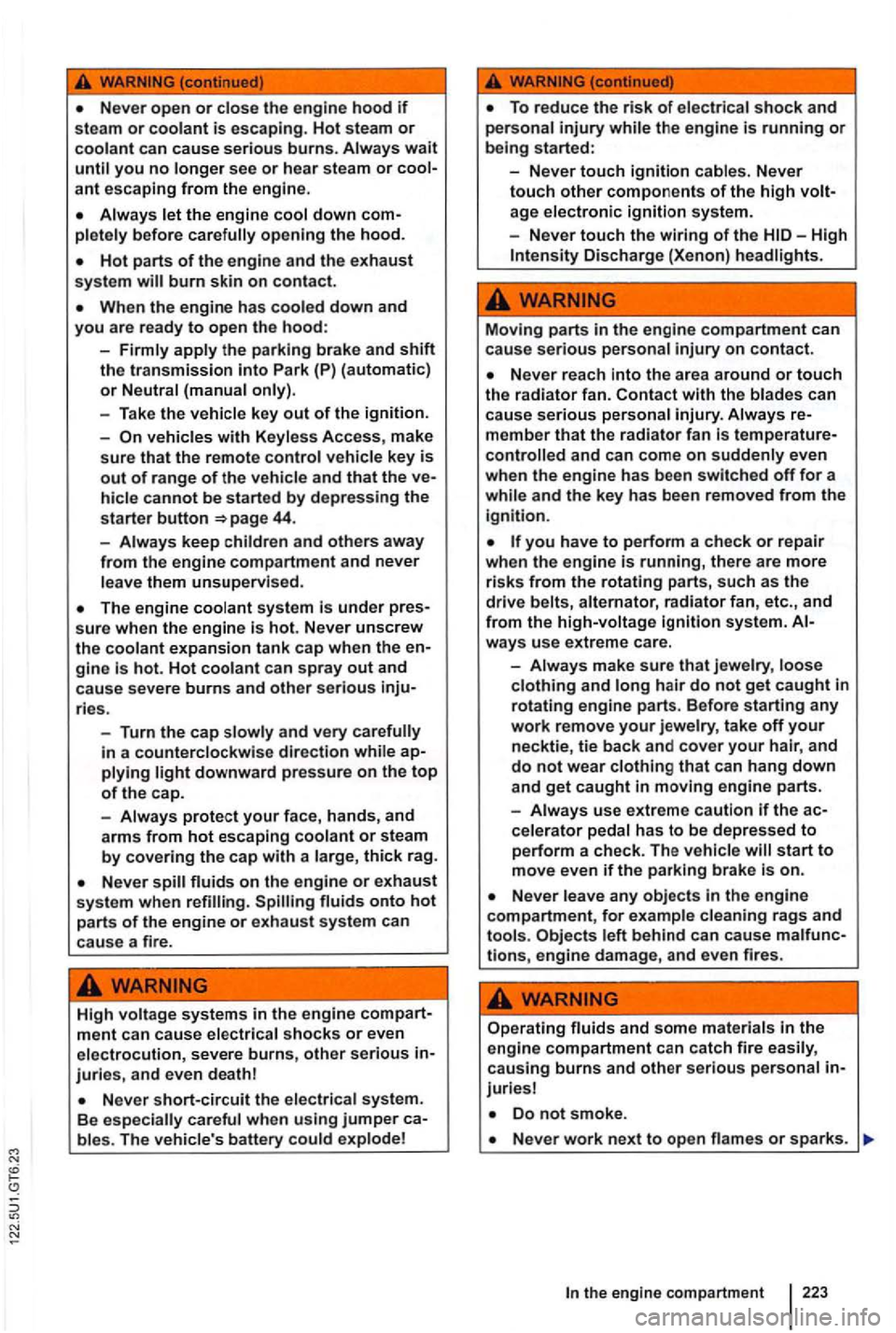
Never open or close the engine hood if To reduce th e risk of electrica l shock and steam or coolant is escaping. Hot steam or personal injury
-Never touch ignition cables. Never ant escaping from the engine. touch other components of the high
Always the eng ine down com-age electronic ignition syste m .
opening the hood.
-Never touch the wiring of the Discharge (Xenon) headlights.
system burn skin on contact.
you are read y to open the hood: Moving parts in th e engine compartment can
- Firm ly apply the parking brake a nd shift cause serious personal injury on contact. the transmission into Park (P) (automatic)
vehicles with Keyless Access, make member that the radiator fan is temperature-
s
ure that the remote contro l vehicle key is controlled and can come on sudden ly even
out of range of th e vehicle and that the ve- when the engine
has been switched off for a
hicl e cannot be started by depres sing the 44. ignition.
-
Always keep children and others away you have to perform a check or repair from the engine compartment and never when the engine is runn ing, there are more leave them unsupervised. risks from the rotating parts, such as the
hair do not get caught in
ries. rotating engine
parts. B efore starting an y
- Turn
the cap
fluids onto hot parts of the engine o r exhaust system can
cause a fire. -
Always use
extreme caution if the ac-
ce lerato r pedal has to be depressed to perform a check. The vehicle will start to move even if the parking brake i s on.
Never leave any objects in the engine compartment, for examp le cleaning rags and tools. Objects left b ehind can cause malfunc-lions, engine damage, and even fires.
High voltage sy stems in the engine com part-ment can ca use electrica l shocks or even
electrocution, severe burns, other serious in-juries, and eve n deathl
Neve r short-circuit the electrica l syste m .
B e especially ca reful when using jumper ca-
Operating fluids and some materials in the engi ne compartment can catch fire easily, causing burns an d other serious personal in-juries
Do not smoke .
b les. The
vehicle 's battery could exp lode! Never work next to open flames or sparks .
223
Page 343 of 516
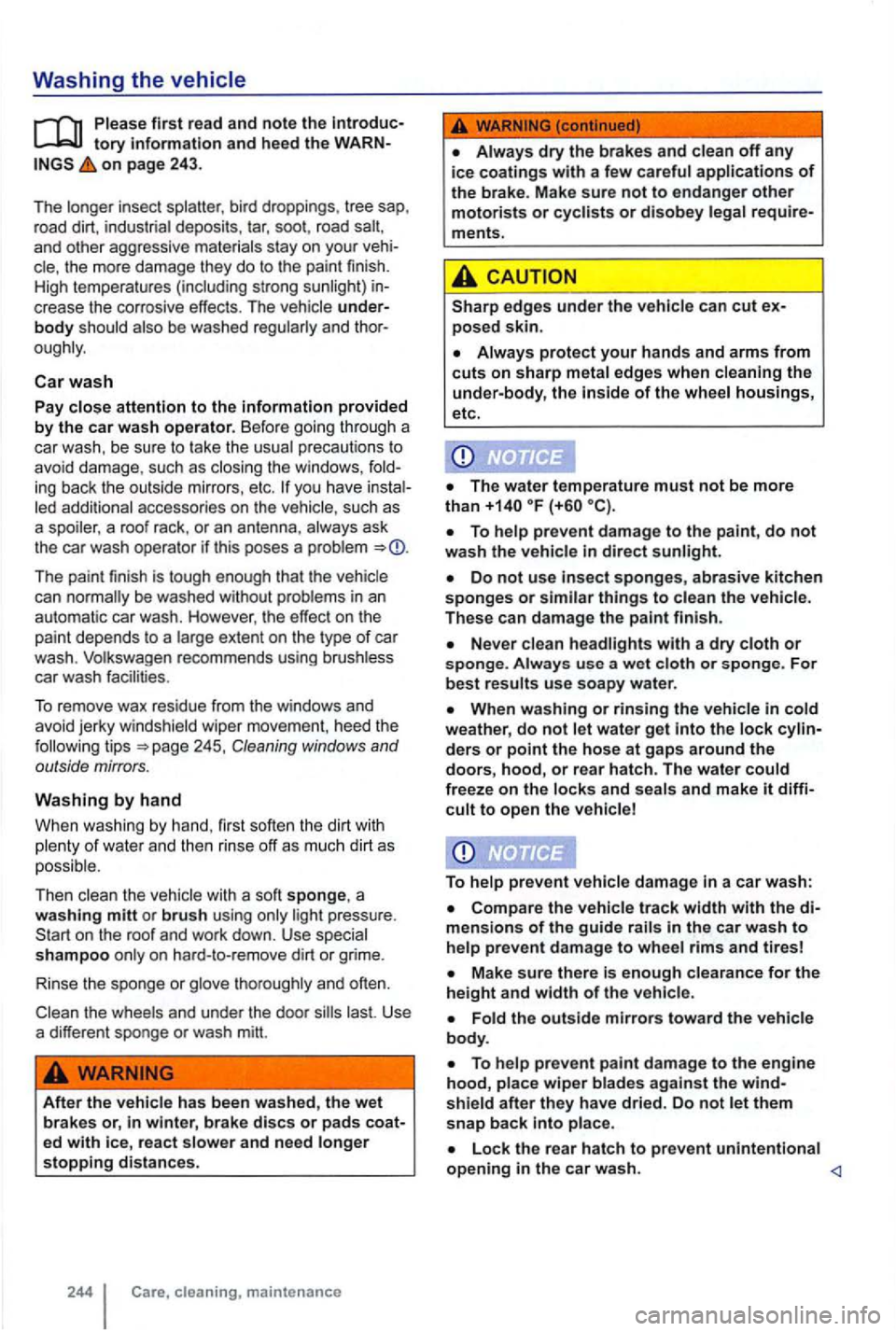
Washing the vehicle
tory information and heed the on page 243 .
T he longer insect splatter , bird droppings, tree sap,
r oad dirt , indust rial deposits , tar , soot , road
and othe r aggressive materials stay on your cle, the more damage they do to the paint finish.
H igh temperatures (includi ng strong sunlight)
oughly.
Car wash
Pay close attention to the information provided
by the car wash operator . B efo re goi ng throu gh a
ca r was h, b e s ure to take th e usual precautio ns t o
avoid damag e , such as closi ng the windows ,
The paint finish is toug h enough th at the vehicle can
the wheels and under the door
After the vehi cle ha s been washed , the wet brakes or, in winter, brake discs or pads ed with ice, react slower and need longer stopping distances .
WARNING
Always dry the brakes and clean off any ice coatings with a few careful applications of the brake . Make sure not to endanger other motorists or cyclists or disobey legal require-
ments .
edges under the vehicl e can cut ex-
posed skin.
Always protect your hands and arms from cuts on sharp metal edges when cleaning the under-body , the inside of the wheel housings,
etc.
The water temperature must not be more
than
Ne ver clean headlights with a dry cloth or sponge . Always use a w et cloth o r s ponge . For best result s use soapy water.
When washing or rinsing the vehicle in cold weather , do not
cult to open the vehicle!
To help prevent vehicle damage
in a car wash:
in the car wash to help prevent damage to wheel rims and tires!
Make sure there is enough clearance for the
height and width of the vehic le .
To help prevent paint damage to the engine
hood, place wiper blades against the shield after they have dried. Do not let them
snap back into place .
Lock the rear hatch to prevent unintentional
opening in the car wa sh .
Page 418 of 516

Fig. 167 o f a blown fuse.
tory information and heed the WARNon page 317.
Preparations
off the headlights . the ignition , and electrical consumers .
the appropriate fuse box
167.
a flashlight on th e fuse. This makes it easier
t o
165 fro m the fuse box cover .
For small fuses, slide the tweezers 168 onto the fuse from the top A. Fig
. 168 Removing
or inserting a fuse using the
p lastic tweezers .
For larger fuses, slide the tweezers onto the
f use from the side B.
the fuse is blown , replace the fuse with a new fuse of the same amperage (same color and same
impri nt) and same overall size
necessary, replace the plastic tweezers in the
fuse box cover .
Replace the cove r.
Practica l tips
Page 421 of 516
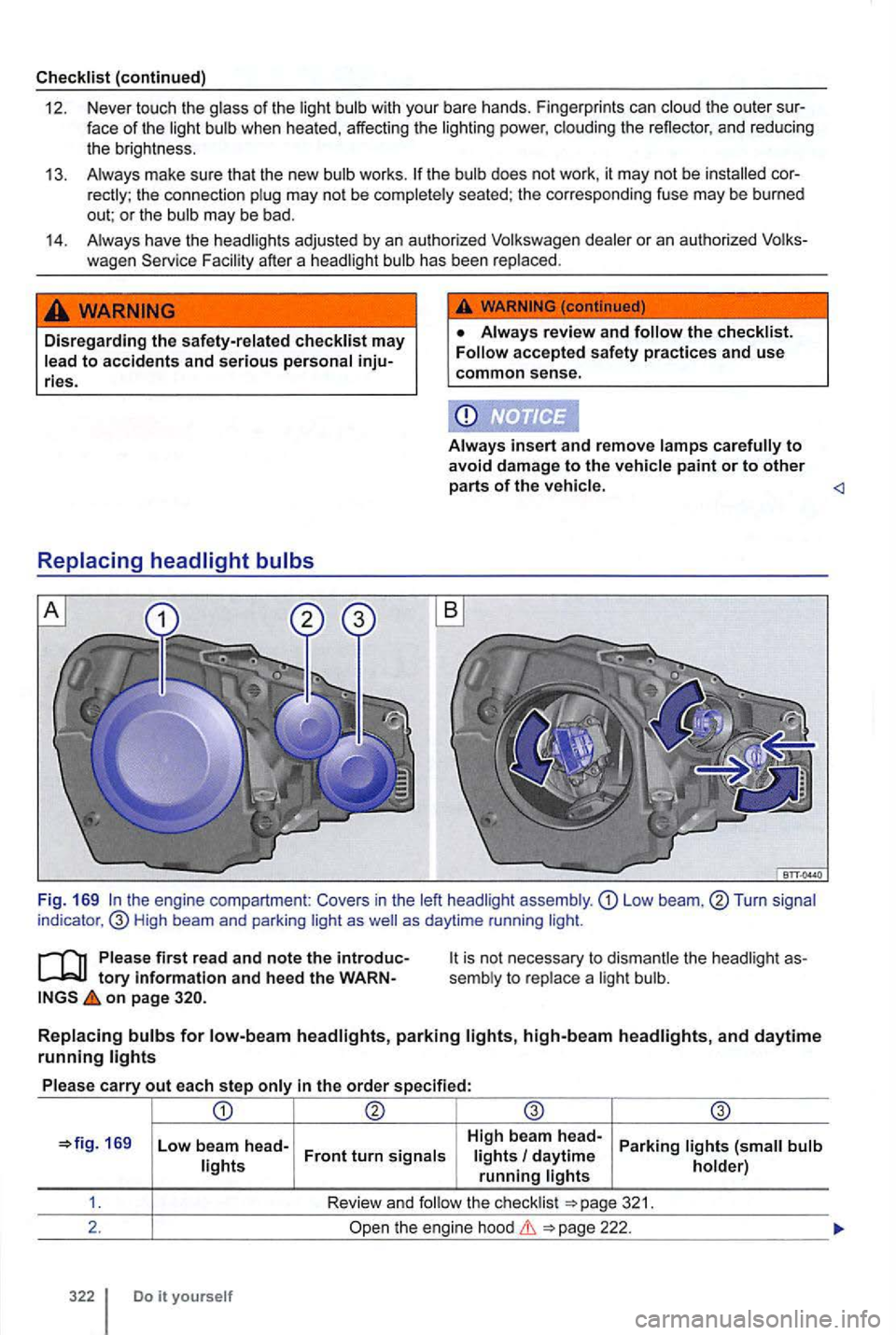
Checklist (continued)
12. Never touch the glass
of the light bulb with your bare hands. Fingerprints can cloud the out er surface of the light bulb when heated , affecting the lighting power, clouding the reflector, and reduc ing
the bright ness .
1 3 . Always make sure tha t the new bulb works .
cor
rectly ; the connection plug may not be complete ly seated ; the corresponding fuse may be burned
out ; or the bulb may be bad .
14. Always have the headlights adjusted by an authorized Volkswage n dealer or an author ized Vol ks
wagen Facility after a headlight bulb has been replaced.
Disregarding the safety-related checklist may
lead to accidents and serious personal injuries.
Replacing headlight bulbs
the checklist. Follow accepted safety practices and use common sense .
Always insert and remove lamps carefully to avoid damage to the vehicle paint or to other parts of the vehicle.
on page
169 Low be am head- High
beam head-
Parking
321.
2 .
the engine hood
Do